- Latest reviews
- Culture
- Live reviews
- Melbourne live reviews
This was published 1 year ago
An unforgettable gig by an artist on the rise
By Kate Jones, Giselle Au-Nhien Nguyen, Andrew Fuhrmann, Kate Herbert, Tony Way, Vyshnavee Wijekumar and Jessica Nicholas
This wrap of shows around Melbourne includes G Flip’s first night at the Forum, a nostalgia-fuelled gig by Evanescence, a show by the Mick Jagger of Australian dance, idk by Force Majeure, the return of glitzy musical Moulin Rouge, a deft and inventive new take on a Shakespeare classic, and more.
MUSIC
Forest Claudette ★★★★★
The Night Cat, September 2
Every successful artist comes to a popularity tipping point where new faces in the audience outnumber those of loyal family and friends.
Such a moment came for Forest Claudette last night at a tightly-packed gig at The Night Cat in Fitzroy (despite their mum being one of the most energetic dancers in the crowd).
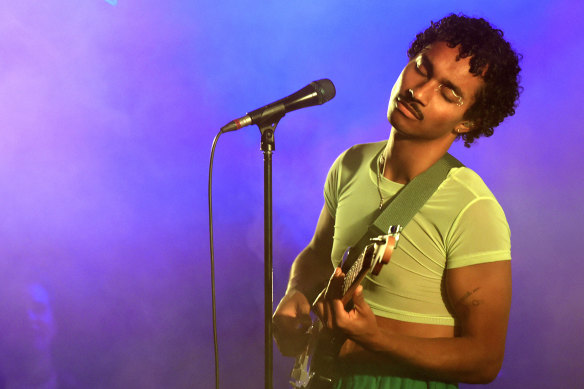
Forest Claudette performs on stage at The Night Cat, September 2, 2023.Credit: Martin Philbey
Even they seemed surprised by the near-500-strong turnout.
“We played our first show in Naarm six months ago and I appreciate the repeaters, but now there’s all these new people. It’s more than we expected,” Claudette laughed.
The up-and-coming R&B artist from the Dandenong Ranges has gathered quite the following after the release of their second EP, Everything Was Green.
Although the new fans may not be familiar faces, they certainly know the songs.
Shout-singing could be heard from the 20-somethings lining the stage when Claudette broke into the melodic Two Years, and again for Gone Without a Trace, while phones rose in unison to capture recordings of every chorus.
It’s easy to see and hear why this 23-year-old is amassing a solid fan base. In between sips of coconut water, they chatted easily and smiled often.
Their range moves from the slow rap of Hi Vis Teeth, a song of gratitude for family and friends, to the stripped-back sadness of Violence, a song inspired by the Black Lives Matter movement.
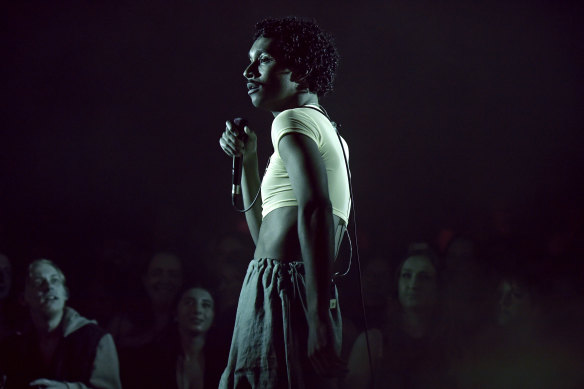
It’s easy to see and hear why Forest Claudette is amassing a solid fan base.Credit: Martin Philbey
“I wrote this song while I was in LA one night, when all I heard was sirens and I wondered who was being chased and whether they looked like me,” they told the audience.
But it’s the laid-back party songs Mess Around and Pool Boy, that really got the crowd jumping.
“Don’t forget about me” Claudette sings in Goodbye, a fitting encore. But no one is going to do that in a hurry.
Reviewed by Kate Jones.
MUSIC
G Flip ★★★★
Forum Theatre, August 29
On the sold-out first night of a three-night stand in their hometown, G Flip is feeling good. “I’ve been playing gigs since I was 14 across Melbourne and the goal was always to play the Forum,” they say, “and now I get to play three of them. I’m crying straight off the bat.”
It’s a victory lap. The non-binary musician’s second album is called Drummer, and they show off their chops, beginning the night with a drum solo and returning intermittently to the kit throughout the show.

G Flip commands Tuesday night’s crowd at the Forum with ease.Credit: Rick Clifford
With three bandmates atop a podium, G Flip stalks the stage and commands the crowd with ease. Their standard pop-rock fare is elevated to something more inspired in the live setting, with a sound big enough for a stadium. Tracks such as Rough, Real Life and Be Your Man come to life in this space, and Australia begins on acoustic guitar and blooms into a full-band jam with an audience gang vocal to boot. A cover of Ginuwine’s Pony could be corny in the wrong hands, but is explosive here.
The house rules are laid early: this is a safe space for the LGBTQIA+ community and those who have mental health struggles – if anyone needs help, the show will immediately stop.
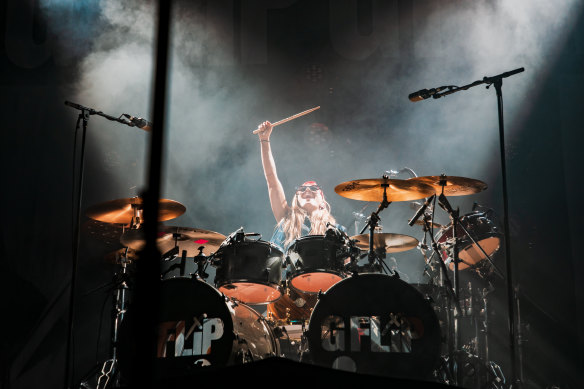
G Flip’s Forum gig is a victory lap.Credit: Rick Clifford
G Flip walks the walk: the show is indeed paused to help a crowd member, who seemed to need water. An Auslan interpreter also shared the stage the whole time. It’s a touching thing to see from a mainstream musician and something more acts would do well to emulate.
What stands out most is how genuine the musician is, whether they’re pointing out their parents and reality TV star wife Chrishell Stause in the crowd, or choosing a fan to give a special piece of merch to. Their charisma and sincerity, and huge stage presence, converted this casual listener to a card-carrying fan.
Reviewed by Giselle Au-Nhien Nguyen
MUSIC
Evanescence ★★★½
Rod Laver Arena, August 30
Never underestimate the power of the nostalgia dollar. Tours celebrating album milestones – 10 years, 15, 20 – are becoming increasingly commonplace, and the latest cab off the rank is American goth-metal band Evanescence. Their debut album Fallen was released in 2003, and brought heavy music to the radio-listening masses.
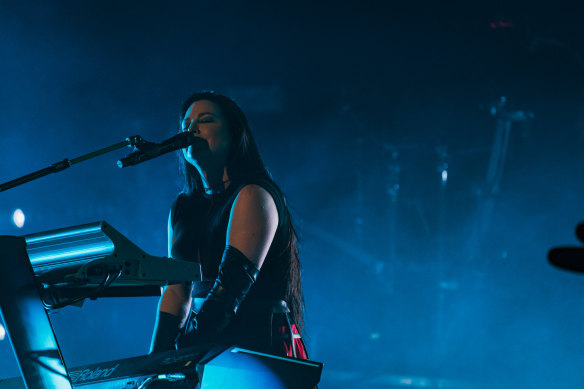
Amy Lee often starts a song by sitting at the piano before it blooms into a full-band number.Credit: Rick Clifford
At Melbourne’s sold-out show, the fans mostly hover around Millennial age, with some bringing along their tweens (raised on these songs, no doubt). Rage Against the Machine’s Killing in the Name plays over the PA just before Amy Lee hits the stage, further cementing the demographic and its tastes.
The show bills itself as a celebration of Fallen and a “career-spanning set of fan favourites”. Lee is the only remaining member from the Fallen era, but she’s the perennial star of the show. Australian bassist Emma Anzai, of the Sydney band Sick Puppies, has recently joined the fold and lends backing vocals.
It’s clear the old stuff is still the most beloved, with the night’s first enormous cheer for Going Under – though newer track Take Cover impresses with nimble bass footwork and a dazzling light display. Lee’s voice is in fine form: she sounds just as good as, if not better than on recordings, with a power and clarity that carries these anthemic songs to great heights.

Amy Lee’s voice is in fine form: she sounds just as good as, if not better than on recordings.Credit: Rick Clifford
She often starts a song by sitting at the piano before it blooms into a full-band number – Lithium, Lose Control and Call Me When You’re Sober all follow this formula. My Immortal is the show’s requisite phone-lights-out moment, and Lee sounds spectacular as she belts the ballad with emotional heft.
When it comes to Fallen, though, it’s a strange choice to mash many of its songs into medleys, along with tracks from 2006’s The Open Door – single Everybody’s Fool is one of the band’s most memorable early hits, but is reduced to just a few lines tonight. Some of Fallen’s tracks, such as Tourniquet and Hello, don’t get a look in at all. While it does give fans the chance to hear more songs, it feels undercooked and is the set’s weakest point.
But when the hits are this strong, it doesn’t seem to matter. The male counterpart is notably missing on closer Bring Me to Life, but the crowd picks up the slack and roars when streamers spill from the ceiling for the grand finale – no encore required. Wake me up, indeed.
Reviewed by Giselle Au-Nhien Nguyen
DANCE
The Real Time It Takes ★★★★
Rosalind Crisp, Dancehouse, until September 9
The blurb advertising Rosalind Crisp’s retrospective performance installation describes the Omeo-born dancer and choreographer as the Mick Jagger of Australian dance. It’s an irresistible hook, but what does it mean?
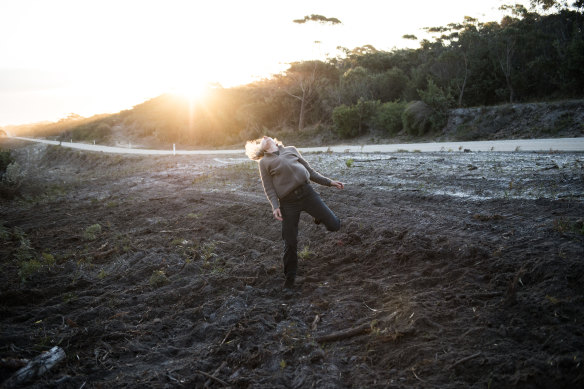
Rosalind Crisp has been described as the Mick Jagger of Australian dance.Credit: Lisa Roberts
It’s true that she knows how to rock out. Think, for example of the last minutes of her 2006 solo – known simply as danse (1) – where she leaps and convulses to revved up sounds classic guitar rock. But that’s Janis Joplin, isn’t it?
Perhaps it’s the swagger. The attitude. The aura. Crisp has always had the power to captivate, to draw the eye and orientate a room around her presence. It’s more than her wiry strength, her long limbs and loping gait. It’s the intensity.
This retrospective features photographs, videos and a few select relics, including a tiny Victorian Ballet School sweatshirt with a roughly scissored scoop neck.
She has been making work for more than three decades, but most of the video documentation in this exhibition is from the period after 2002, when she relocated to Paris. There are selections, too, from her more recent environmentally engaged work.
The highlight is an extended live performance by Crisp, during which she muses aloud on what it means to look back on a career. Her improvisations are energetic but inflected by sombre tone. She dances like someone who can’t go on – but must.
At the end of the show, the light fades but Crisp continues to dance. She is still searching, still questing through gesture, exploring the possibilities of form, cutting, fragmenting and then piecing together.
Even now she can’t get no satisfaction. She must keep moving and inventing. What is a retrospective if not the creation of a new myth? So embrace the marketing hype, get over to Dancehouse and revel in the presence of this dancer who might also be a rock star.
Reviewed by Andrew Fuhrmann
DANCE
idk ★★½
Force Majeure, Arts House, until September 2
The ongoing debate about consent and how it’s defined is challenging. Any work of theatre or dance that can make a contribution – by evoking empathy, raising awareness, shifting preconceptions, modelling solutions or galvanising support – should be welcomed.
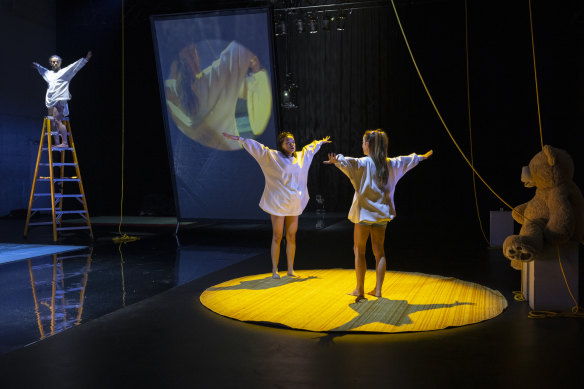
idkCredit: Brett Boardman
It’s therefore unfortunate that this latest offering from Sydney-based dance company Force Majeure is so distant, so inward, so awkwardly put together and so difficult to engage.
Directed by Danielle Micich, the work is composed of a series of vignettes, each of which proposes a different perspective on the need for affirmative consent.
These scenarios, performed by three dancers, range from realistic interactions to expressionistic solo dances.
It begins – slowly, oddly – with a baby and a giant teddy bear. Or perhaps it’s a man in a nappy and a woman in a bear suit. Is the relationship between child and toy offered as a pattern for relationships where consent is lacking? It’s hard to say.
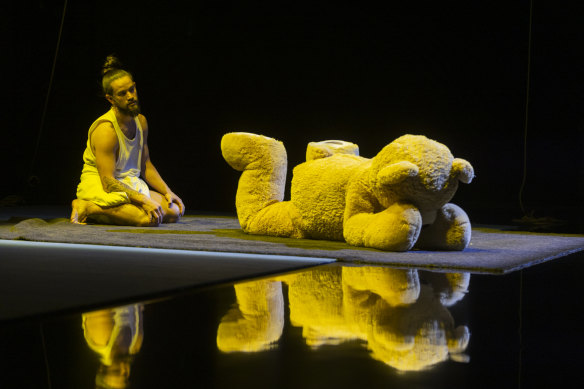
Gabriel Comerford and Adriane Daff (in a teddy bear costume) in a scene from Force Majeure’s idk.Credit: Brett Boardman
Overall, I think the work strives to make at least two contributions. The first is to assert that consent means dialogue rather than box-checking. And the second is that consent is also a form of self-knowledge. You have to understand what you want.
And yet for a show that circles compulsively around themes of communication and knowledge, idk is frustrating because it is so incommunicative and hard to follow.
There are technical reasons for this: the ineffective use of video, the clumsiness of the text, the banality of the choreography and the placement of scenes on the distant edges of the stage. What I really missed, however, was an attempt to reach out to the audience.
It’s telling that the only time the audience is addressed directly is when the giant bear tells the story of its abandonment.
It’s funny but also a surreal distraction and hardly the sort of conversation starter that is needed.
Reviewed by Andrew Fuhrmann
DANCE
Ascent, Sydney Dance Company ★★★★
Arts Centre Melbourne, until December 2
Sydney Dance Company has at last arrived in Melbourne with their latest triple bill, having spent the past four months crisscrossing the continent. Ascent, however, is well worth the wait because it features a frisky new commission from Spanish choreographer Marina Mascarell.
Mascarell’s piece is called The Shell, A Ghost, The Host & The Lyrebird. Huge silk sheets with panels of red, white and green are hung from the rigging, which the dancers heave about the stage using pulleys and a dozen or so thick ropes.
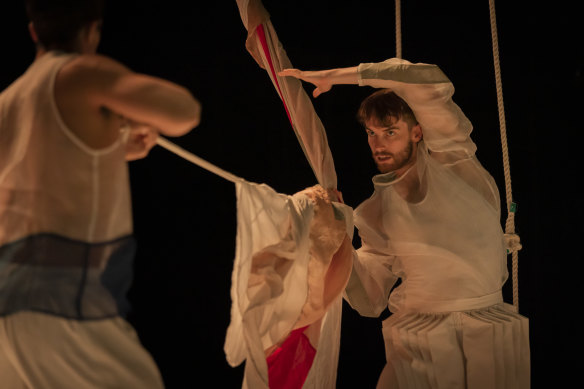
A scene from The Shell, A Ghost, The Host & The Lyrebird, choreographed by Marina Mascarell.Credit: Pedro Greig
What does all this gear suggest? A ship’s rigging, perhaps? Or a deconstructed dirigible from a Munchausen fantasy? It’s a puzzle, but there’s vitality enough in Mascarell’s dance ideas. And the work is performed with dash and sparkle by the ensemble of seven.
Company mainstay Jesse Scales proves irresistible leading the troupe through a series of witty transformations: from marionettes to animal hybrids to malfunctioning androids. Meanwhile, the soundscape merges birdsong with glitchy bleeps.
The program also features a revival of Forever & Ever, Antony Hamilton’s exuberant, five-year-old homage to the pomp and pageantry of street dance competitions. It’s a wonderfully gimmicky full-company performance with the bigness of a comic book come to life.
Hamilton rehearses the conventions of dance battles as if they were so many alien rituals dreamed up for a galaxy-spanning space opera. It’s wildly entertaining, performed with deliciously absurd blank-faced seriousness by the dancers.
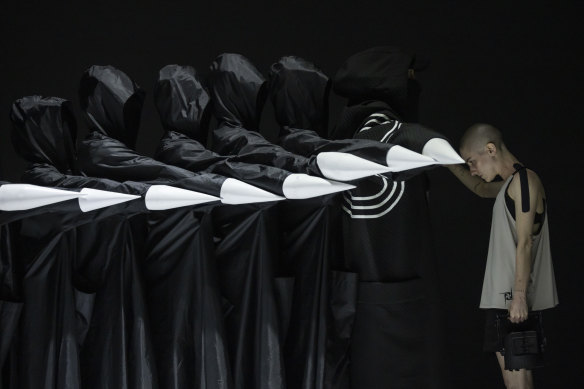
Forever & Ever, choreographed by Antony Hamilton.Credit: Pedro Greig
The third piece on the program is a short pas de quatre by company artistic director Rafael Bonachela, set to a trembling bit of expressionism for strings and solo violin by Peteris Vasks called Lonely Angel.
It’s not much more than an extended study in coiling forms and lingering caresses. The sustained lyricism is a little too gooey for my taste and I found myself wishing that these half-naked angels would quit their endless foreplay and decamp to a hotel.
And yet, this takes nothing away from Sydney Dance Company because this is a fine evening of entertainment.
Reviewed by Andrew Fuhrmann
MUSICAL
Moulin Rouge! The Musical ★★★
Regent Theatre, until December 31
If there’s one word for Moulin Rouge! The Musical, it’s excess. Like Baz Luhrmann’s 2001 film, on which it is loosely based, this production is all about glitz and glam, with eye-popping (if not slightly tacky) stage design, choreography, costuming and colour.
The theatre is transformed into the interior of the titular club – a lit-up windmill spins, and a five-metre-tall elephant looms over the crowd. Performers swallow swords and descend from the ceiling. There’s confetti and pyrotechnics.
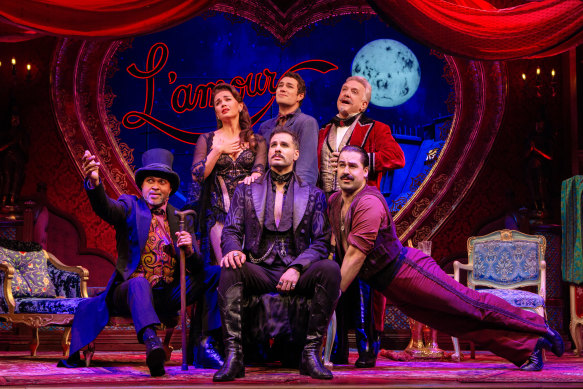
Moulin Rouge! The Musical stars Alinta Chidzey as Satine, Des Flanagan as Christian, Simon Burke as Harold Zidler, along with Bert La Bonté as Toulouse-Lautrec, James Bryers as The Duke and Ryan Gonzalez as Santiago.Credit: Chris Parker
The spectacular musical is back in Melbourne after a sellout season in 2021, which signalled a post-COVID return to splashy, big-ticket theatre. The cast is again led by Alinta Chidzey and Des Flanagan as Satine and Christian – the Moulin Rouge’s top courtesan and the bohemian American writer vying for her affections.
Since the show last played, a challenger has appeared: it’s difficult not to compare Moulin Rouge! The Musical to the new kid on the block, & Juliet. Both are jukebox musicals, but where & Juliet leans into campiness and uses its music (all by Swedish hitmaker Max Martin) cohesively, Moulin Rouge! The Musical goes – again – for excess.
The sheer number of pop songs shoehorned into the show – around 70 – is exhausting. Most are peppered in as one-liners, feeling more like a game of “name that tune” than anything substantial.
Some of it works well – the opening number, including Lady Marmalade, is a treat, and a drunken descent to Sia’s Chandelier is literally intoxicating – but more often, songs are mashed haphazardly and pivotal points are diluted by limp choices (Satine singing Katy Perry’s Firework doesn’t pack the emotional punch the moment requires).
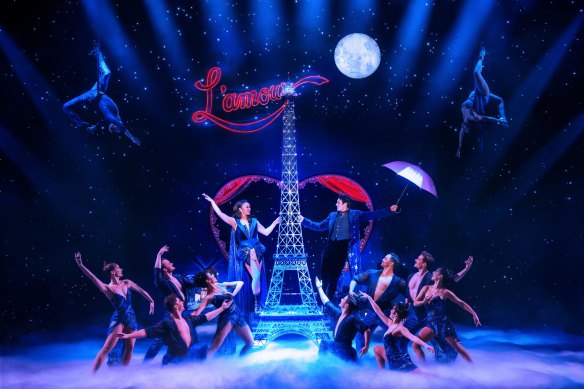
Moulin Rouge! The Musical is all about glitz and glam.Credit: Michelle Grace Hunder
Indeed, the best number is Come What May, the film’s only original track, where Chidzey and Flanagan’s voices meld beautifully.
This musical gluttony comes at the expense of character and plot development – it’s hard to feel much for any of these characters when we’re barely given the chance to know them.
The subject matter also feels dated, as Christian and a wealthy benefactor, The Duke (James Bryers), fight over Satine; Christian’s characterisation in particular verges on manipulative, and the language can be paternalistic.
While this version does give Satine more agency than a fully tragic heroine, she ultimately remains a catalyst for a man’s self-actualisation.
Moulin Rouge! The Musical is a feast for all the senses – it looks stunning and the performances are mostly strong. It has style in spades and it’s impossible not to feel wowed by its enormous scope – but it leaves a feeling of emptiness.
THEATRE
Julius Caesar ★★★½
Melbourne Shakespeare Company, fortyfivedownstairs until September 3
When Natasha Herbert’s Marc Antony howls, “Cry ‘Havoc!’, and let slip the dogs of war”, her passion and vocal power rouse volatile Romans to violent action, sending a thrill through the audience.
Shakespeare’s play may be entitled Julius Caesar, but the characters driving the action are Antony and Brutus (Matthew Connell). Antony, who remains Caesar’s trusted right hand, and Brutus, who is Caesar’s political ally until Brutus’s defection.
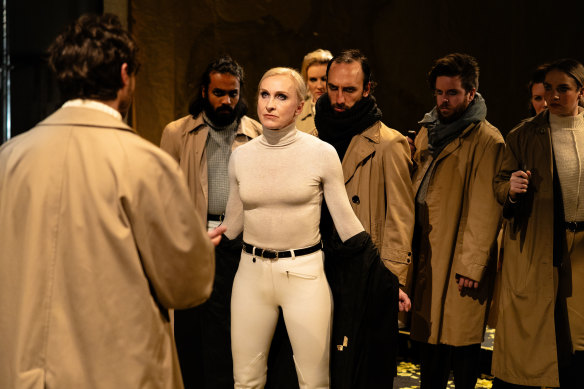
A scene from Melbourne Theatre Company’s Julius Caesar at fortyfivedownstairs.Credit: Chelsea Neate
The play opens with statesman and general, Caesar (Hunter Perske), arriving in Rome to a triumphant parade after his military defeat of rival, Pompey. With feigned humility, Caesar thrice rejects Antony’s offer of a crown. This confirms Cassius’ (Mark Wilson) fears for the Roman Republic, so he exhorts Brutus to join a plot to assassinate Caesar to save and restore freedom, peace and liberty.
What follows is a galloping escalation of intrigue and treachery, political crisis, murder, divisiveness and civil war under opposing leaders: honourable but indecisive Brutus and gifted orator, Antony. The Roman public is fickle, violence simmers, the government is fragile, and leaders are not necessarily altruistic.
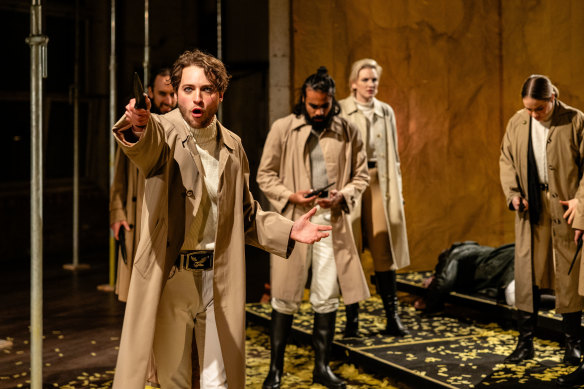
Mark Wilson (left), Matthew Connell, Malith, Jacqueline Whiting and Annabelle Tudor in Julius Caesar.Credit: Chelsea Neate
Richard Murphet’s deft, inventive, streamlined direction propels the narrative and main characters from conspiratorial beginning to bloody end. His interpretation of Shakespeare’s text is crystal clear, emphasising the humanity of the characters, while the intimacy of their relationships heightens the sense of betrayal.
Herbert’s gripping portrayal of Antony is the beating heart of this production as she transforms from grief-stricken friend to impassioned orator and, finally, astute and dispassionate military strategist.
Her textual interpretation, and physical and vocal technique are impeccable, and her delivery of Antony’s “Friends, Romans, countrymen” speech is thrilling.
Although Connell is a more youthful Brutus than is common, he captures Brutus’s nobility, self-doubt and indecision as he faces the enormity and inexorability of his actions. While the quality of the cast’s acting is uneven, Wilson vibrates with rage as “lean and hungry” Cassius, Mark Yeates captures Casca’s roguish wit and cunning and Perske’s robust physique lends substance to the ageing, weakening Caesar who fears ill omens.
Kris Chainey’s atmospheric lighting and Grace Ferguson’s evocative soundscape enhance Dale Ferguson’s inspired design that incorporates the basement venue’s distressed brick walls, rough-framed windows and wooden floor, utilising its wide space for a colonnade of scaffolding poles, and three, low steps depicting the site of Caesar’s murder.
Murphet’s intelligent production of Shakespeare’s play invites comparisons with contemporary geopolitics that sees some leaders surf a wave of popularity to become Caesar-like autocrats.
Reviewed by Kate Herbert
MUSIC
Art of the Symphony ★★★★
Melbourne Chamber Orchestra, Melbourne Recital Centre, August 27
Janus, the mythical god who looks forward to the future and back to the past, could well have been an inspiration for this thoughtfully curated celebration of the symphony by the Melbourne Chamber Orchestra. Positive, forward-looking elements came with a collaboration and a commission.

This performance of the Art of the Symphony bodes well for the future of the Melbourne Chamber Orchestra.Credit: Jessica Tremp
Four students from the Victorian College of the Arts Secondary School joined the orchestra for Benjamin Britten’s Simple Symphony. Raistlin Chan, Hannah Tyrell, Tom Protat and Chiara Kelle fit seamlessly into a polished and engaging account of this popular work, in which the composer’s descriptions of the movements (Boisterous Bourree, Playful Pizzicato, Sentimental Sarabande and Frolicsome Finale) came vividly to life.
Two sinfonias by the 17th century Flemish musician and composer, Leonora Duarte, preceded the premiere of a specially commissioned work by Melbourne-based composer and cellist Caerwen Martin. Sinfonia No. 1 Embracing Duarte is a broad, imaginative sonic canvas that embraces elements of Duarte’s writing for viols and reinterprets them in a sympathetic contemporary harmonic and textural language. Among some heart-warming moments came a demanding violin cadenza brilliantly rendered by MCO director Sophie Rowell.
Book-ending the concert were works honouring the history of the symphonic form. Carl Stamitz’s Symphony in F major Op. 24, No. 3 elicited carefully refined playing; the orchestra’s warm, generous body of sound particularly impressing in the slow movements. Haydn’s Symphony No. 49 in F minor certainly lived up to its nickname: the “Passion” Symphony. Pulsing with sparkling energy and attention to detail, all the drama and elegance of this fine but little-known score was given full expression.
This concert was marked by fine playing and a joyous team spirit together with a blend of respect for the past and hope for what is to come. As Rowell journeys through her first season as director, the performance bodes well for the future of the MCO.
Reviewed by Tony Way
MUSIC
J.I.D | Forever & A Day Tour ★★★
Festival Hall, August 26
A loud cheer erupts from the crowd as a spotlight shines on J.I.D’s producer – and DJ accompaniment – Christo. From his spot in the DJ booth, he encourages everyone to “make some noise” as the 32-year-old rapper steps on stage.
Atlantan musician J.I.D first rose to fame in 2014 as part of the collective Spillage Village, before signing with rapper J.Cole’s imprint Dreamville Records in 2017. His Melbourne concert marks the 12-month anniversary of his 2022 third studio album, The Forever Story.
The rapper opens with NEVER, a track off his debut album The Never Story and moves into Off da Zoinkys from the album Dicaprio 2, before launching into newer songs Raydar and Dance Now. He confidently spits lyrics a capella when Christo silences the beats, showing off his signature fast-paced technique in the final verse from Off da Zoinkys. Christo occasionally joins J.I.D as he paces the stage and works the crowd.

US rapper J.I.D performs in Melbourne.Credit: Rick Clifford
Reflecting on his latest album, J.I.D describes The Forever Story as “a communal album … a family album”.
The mood of the gig shifts as he switches to slower, more sentimental tracks Bruddanem, Sistanem and Kody Blu 31, which centre on his relationship with his parents and siblings, and Stars, which explores his former aspirations to emulate other rappers from the American South, including André 3000, Kanye West and Lil Wayne.
J.I.D’s faithful fan base loudly chants his name and shouts his own lyrics back to him, becoming more inebriated and rowdy as the show goes on. The gig rounds out with a set list built around fan requests, including the track 2007 — a late addition to The Forever Story. Across the performance, the lighting was unpredictable, going from a fully lit stage between songs to bright LED lights while J.I.D was performing, making things feel more like an RnB/Hip Hop club rather than a music venue.

J.I.D’s signature fast-paced technique was on show at his Festival Hall performance. Credit: Rick Clifford
A strong performance, but the inconsistent visual effects and audience’s unruliness ultimately detracted from the overall experience.
Reviewed by Vyshnavee Wijekumar
MUSIC
All Rise: Jazz at Lincoln Centre Orchestra with Wynton Marsalis and The MSO ★★★★½
Hamer Hall, August 25
Even before a note is played, it’s impossible not to be dazzled by the scale of Wynton Marsalis’ Symphony No.1, All Rise. The mere sight of 180 performers occupying every inch of the stage at Hamer Hall on Friday night was enough to inspire awe.
A 12-movement work for a symphony orchestra, jazz orchestra and 100-strong choir, All Rise is epic in its scope and ambition. It represents a 12-bar blues writ large, reflecting our journey through life in individual, communal and spiritual terms.
It’s a dense and elaborate work, brought to vivid life at its Melbourne premiere by New York’s Jazz at Lincoln Centre Orchestra, the Melbourne Symphony Orchestra and an imposing choir comprised of the MSO Chorus and Consort of Melbourne.
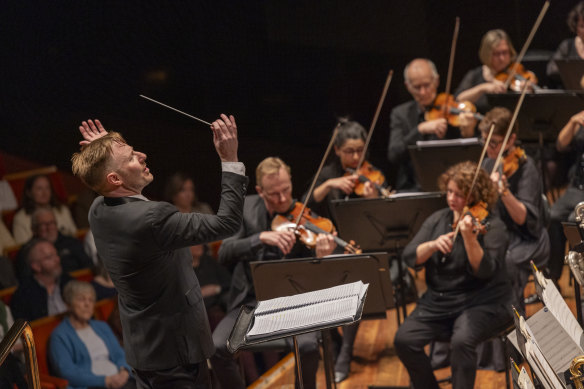
Even before a note is played, it’s impossible not to be dazzled by the scale of Wynton Marsalis’ Symphony No.1, All Rise.Credit: Nico Photography
Conductor Ben Northey used gestures both compact and expansive to direct sections of the combined ensembles as they intersected, diverged and converged. The early movements (representing birth and self-discovery) hummed with energy and ever-changing musical colours, from syncopated percussion to lush Ellingtonian brass, graceful string-led swells and strident Appalachian-style fiddling.
The middle movements descended into the darkness of sin, self-doubt and existential crisis. “Save us!” the choristers intoned mournfully, as a New Orleans funeral procession gradually gave way to a more optimistic mood.
Redemption earned, we entered a kaleidoscope of irresistible South American dance styles – mambo, milonga, tango – and embarked on a pulsating locomotive in Expressbrown Local. The pure-toned vibrato of Melbourne jazz singer Michelle Nicolle ushered in the rousing final movement, urging the full ensemble to unite for a dramatic crescendo that unexpectedly gave way to a jubilant Dixieland celebration.
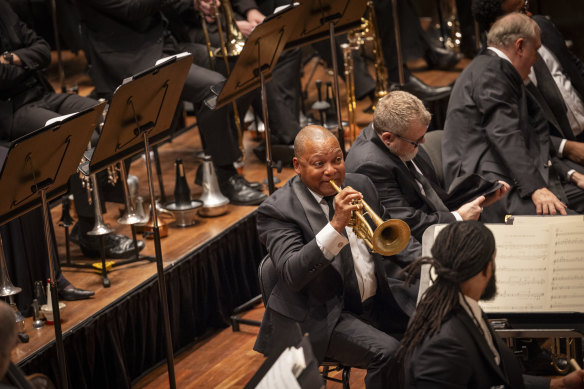
All Rise is a deeply compelling synthesis of Marsalis’ musical, personal and spiritual beliefs.Credit: Nico Photography
The multi-layered complexity and constant rhythmic, harmonic and tonal shifts made for a demanding (occasionally exhausting) listen, but All Rise is a deeply compelling synthesis of Marsalis’ musical, personal and spiritual beliefs. Marsalis himself remained ensconced within the trumpet section, but his artistic voice resonated throughout – dressed in symphonic garb, but with jazz and blues at its fiercely beating heart.
Reviewed by Jessica Nicholas
MUSICAL
Becoming Eliza ★★★½
Anna O’Byrne, Comedy Theatre, August 26
Anna O’Byrne boasts a stellar international career spanning opera and musicals, and has become Australian musical theatre royalty, having played Christine Daaé in Love Never Dies and in Phantom of the Opera in the West End. But it is her becoming Eliza Doolittle in Opera Australia’s 2016 production of My Fair Lady, directed by the original Eliza, Dame Julie Andrews, that is the substance of this solo, self-narrated musical journey.
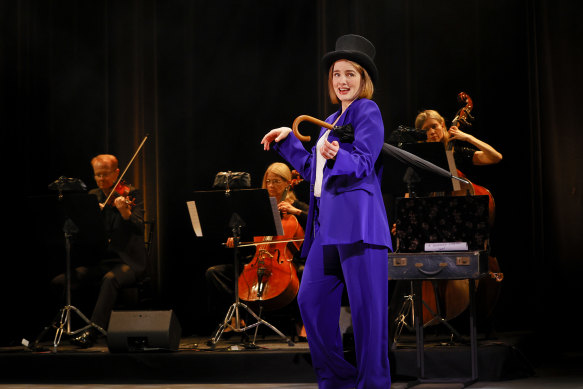
Anna O’Byrne has become Australian musical theatre royalty.Credit: Jeff Busby
Dressed in a simple, loose-fitting, purple pantsuit – a stark contrast to the exquisite Cecil Beaton gowns that she wore in My Fair Lady – O’Byrne addresses her doting audience directly, charming and enthralling them with evocative descriptions of her career with all its soaring successes and some soul-destroying failures.
The simple but effectively constructed, chronological narration, written by O’Byrne, is peppered with backstage anecdotes and coloured with vivid, often lyrical language.
She interweaves excerpts of songs from My Fair Lady and other musicals between true tales from her long, chequered and arduous path to playing Eliza: the audition process, the waiting, the crushing initial rejection call, meeting the warm and generous Julie Andrews again, then the unexpected offer to play Eliza that was both exhilarating and terrifying.
What follows is the gruelling rehearsal process with all its ups and downs and self-doubt, and O’Byrne describes how, on her path to becoming the character of Eliza, she experiences the fictional Eliza becoming her real and constant companion.
This type of confessional, revelatory solo performance could veer into the mawkish or self-indulgent, but O’Byrne thankfully avoids that by remaining down to earth and relatable.
O’Byrne’s soprano has a thrilling upper register and a fine vibrato. Her voice can be bold and powerful, warm and enchanting or sweetly delicate, making it perfectly suited to the repertoire of songs that includes favourites such as I Could Have Danced All Night, Wouldn’t It Be Loverly?, My Favourite Things, In My Own Little Corner and I Have Confidence.
Sharon Millerchip, a doyen of musical theatre herself, directs the show unobtrusively, with outstanding musical accompaniment on piano by celebrated musical director, Michael Tyack, with violinist Roy Theaker, cellist Kalina Krusteva and Katri Tuomennoro on double bass.
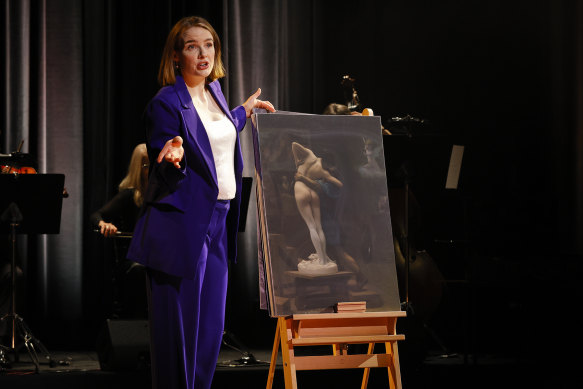
Anna O’Byrne tells the story of Becoming Eliza in her one-woman show.Credit: Jeff Busby
The musicians not only play the tunes, but underscore the narration, establishing the atmosphere for each episode of O’Byrne’s story.
Becoming Eliza is a backstage musical story without the actual musical, and O’Byrne captivates the audience with her revealing personal stories, impeccable voice and her convivial onstage presence. It is a show for O’Byrne fans and aficionados of classic musicals.
Reviewed by Kate Herbert
The Booklist is a weekly newsletter for book lovers from books editor Jason Steger. Get it every Friday.